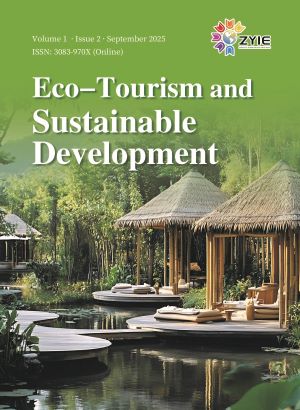Tourism Project Screening Approach in Environmental Impact Assessment in Vietnam
DOI:
https://doi.org/10.63385/etsd.v1i2.235Keywords:
Tourism, EIA, Tourism Project, Tourism Project ScreeningAbstract
In the context of the strong development of the tourism industry in Vietnam, tourism projects are increasingly expanding in scale and location, especially in environmentally sensitive areas such as special-use forests, coastal areas and nature reserves. Although they contribute greatly to economic growth and employment, these projects also pose many risks of causing negative impacts on the environment and society. Environmental impact assessment (EIA) is an important management tool to identify and control such impacts. Screening is the first and very important step to help determine whether a project requires an EIA or not, bringing many benefits in terms of efficiency and environmental management. However, current project screening is still done in a formal and ineffective manner, leading to impractical EIA reports that do not focus on core issues. This study focuses on analyzing the role, current status and limitations of the screening step in EIA of tourism projects in Vietnam, and proposes a new, flexible approach, combining qualitative and quantitative methods, to improve the quality and effectiveness of this step. The proposed 6-step screening process helps to identify major impacts early, save resources and increase transparency in decision-making. The study also recommends improving the legal framework, enhancing staff training, applying technology and promoting the role of the community in monitoring and feedback. This is an important basis for improving the quality of EIA and moving towards sustainable tourism development.
References
[1]Anh, T., 2025. To make tourism a spearhead economic sector. Available from: https://nhandan.vn/dua-du-lich-tro-thanh-nganh-kinh-te-mui-nhon-post854928.html (cited 15 April 2025).
[2]Thi, T.D., 2016. Solutions to develop Vietnam tourism into a spearhead economic sector. Journal of Economics and Finance. Available from: https://tapchikinhtetaichinh.vn/giai-phap-phat-trien-du-lich-viet-nam-tro-thanh-nganh-kinh-te-mui-nhon.html (cited 25 April 2025).
[3]Tian, C., Peng, J., Zhang, W., et al., 2019. Tourism Environmental Impact Assessment Based on Improved Ahp and Picture Fuzzy Promethee Ii Methods. Technological and Economic Development of Economy. 26(2), 355–378. DOI: https://doi.org/10.3846/tede.2019.11413
[4]Guarascio, F., Nguyen, P., 2024. UNESCO to study development risks to Vietnam's Ha Long Bay. Available from: https://www.reuters.com/world/asia-pacific/unesco-study-development-risks-vietnams-ha-long-bay-2024-12-20 (cited 21 April 2025).
[5]Nguyen, C.T., Downes, N.K., Sitthi, A., et al., 2025. Tourism-Induced Land Use Transformations, Urbanisation, and Habitat Degradation in the Phu Quoc Special Economic Zone. Urban Science. 9(1), 11. DOI: https://doi.org/10.3390/urbansci9010011
[6]Xuan, P., 2011. Environmental Impact Assessment (EIA): An important legal tool for environmental protection. Government Electronic Newspaper. Available from: https://baochinhphu.vn/danh-gia-tac-dong-moi-truong-dtm-cong-cu-phap-ly-quan-trong-bao-ve-moi-truong-102108055.htm (cited 16 November 2024).
[7]Nhi, T., 2022. Practice of environmental impact assessment in Vietnam. Online Finance—Economics Journal. Available from: https://tapchikinhtetaichinh.vn/thuc-tien-cong-tac-danh-gia-tac-dong-moi-truong-o-viet-nam.html (cited 01 November 2024).
[8]Pope, J., Wessels, J.-A., Douglas, A., et al., 2019. The potential contribution of environmental impact assessment (EIA) to responsible tourism: The case of the Kruger National Park. Tourism Management Perspectives. 32, 100557. DOI: https://doi.org/10.1016/j.tmp.2019.100557
[9]Glasson, J., Therivel, R., 2019. Introduction to Environmental Impact Assessment, 5th ed. Routledge: London, UK. p. 394. DOI: https://doi.org/10.4324/9780429470738
[10]Tuong, N.T., 2025. Research proposes environmental impact assessment framework for tourism projects. In Proceedings of the 21st international conference socio-economic and environmental issues in development, Hanoi, Vietnam, 11 June 2025; pp. 2925–2938.
[11]Baird, M., 2020. Environmental Impact Assessment in Southeast Asia. Heinrich Böll-Stiftung Southeast Asia. Available from: https://th.boell.org/en/2020/05/12/eia-southeast-asia (cited 9 November 2024).
[12]Environmental Studies (EVS) Institute, 2024. Environmental Impact Assessment: EIA Screening Process: Determining When Environmental Impact Assessment is Needed. Available from: https://evs.institute/environmental-impact-assessment/eia-screening-process-when-assessment-needed (cited 12 May 2025).
[13]Institute of Sustainability and Environmental Professionals, 2025. EIA screening: changes and challenges. Available from: https://www.isepglobal.org/articles/eia-screening-changes-and-challenges (cited 10 July 2025).
[14]International Institute for Sustainable Development (IISD), 2025. The 7 Steps to an EIA, Learn—Step 1: Screening. Available from www.iisd.org/learning/eia/eia-7-steps/step-1-screening/?__cf_chl_rt_tk=tzzK52xHOJUOdPofO1nywrmGshyneI76cdv89a4UG4M-1760604472-1.0.1.1-D9IVGp97EADXM0YBKe3QFCuEh6QWZG.Jg.WwqoSBvZE (cited 9 July 2025).
[15]Trinh, L., 2020. Environmental impact assessment: methods and applications. Science and Technology Publishing House: Hanoi, Vietnam, pp. 131–132.
[16]Pröbstl-Haider, U., 2022. EIA Effectiveness in Sensitive Alpine Areas: A Comparison of Winter Tourism Infrastructure Development in Germany and Austria. Sustainability. 14(15), 9775. DOI: https://doi.org/10.3390/su14159775
[17]Vietnam Academy of Science and Technology, 2006. Environmental impact assessment of development projects (Procedures and technical guidelines). Statistical Publishing House: Hanoi, Vietnam. pp. 27–28.
[18]Department of nature conservation and biodiversity—center for biodiversity investigation and monitoring, 2023. Screening and preventing the risk of environmental pollution. Available from: https://cebid.vn/sang-loc-ngan-chan-nguy-co-gay-o-nhiem-moi-truong (cited 19 May 2025).
[19]Warnken, J., Buckley, R., 1998. Scientific quality of tourism environmental impact assessment. Journal of Applied Ecology. 35, 1–8. Available from: https://besjournals.onlinelibrary.wiley.com/doi/pdf/10.1046/j.1365-2664.1998.00288.x (cited 16 November 2024).
[20]Jie, W., Wan-qi, B., Guo-hang, T., 2020. A review on ecological risk assessment of land use. Journal of Natural Resources. 35(3), 576. DOI: https://doi.org/10.31497/zrzyxb.20200306
[21]Natural Resources and Environment Newspaper, 2019. The case of "A series of violations at Con Den Eco-tourism Area": Whose responsibility is it?. Available from: https://nongnghiepmoitruong.vn/vu-hang-loat-sai-pham-tai-khu-du-lich-sinh-thai-con-den-trach-nhiem-thuoc-ve-ai-d629361.html (cited 11 February 2025).
[22]Quang, N., Van D., 2022. Quang Ninh: Close-up of the Eco-tourism Area that encroaches on a National Monument. Available from: https://phapluatmedia.vn/quang-ninh-can-canh-khu-du-lich-sinh-thai-xam-hai-di-tich-cap-quoc-gia-19177.html (cited 22 March 2024).
[23]Minh Phuong Investment Consultancy and Construction Design Joint Stock Company, 2020. Steps to prepare EIA report STEP 1: SCREENING. Available from: http://lapduan.com/tu-van-moi-truong/cac-buoc-lap-bao-cao-dtm-buoc-1-sang-loc.html (cited 11 February 2024).
[24]Government, 2022. Decree No. 08/2022/ND-CP: detailing a number of articles of the Law on Environmental Protection. The Government of Vietnam: Hanoi, Vietnam.
[25]National Assembly, 2020. Law on Environmental Protection: Law No. 72/2020/QH14. The Government of Vietnam: Hanoi, Vietnam.
Downloads
License
Copyright (c) 2025 Nguyen Thanh Tuong

This work is licensed under a Creative Commons Attribution 4.0 International License.



 PDF
PDF
